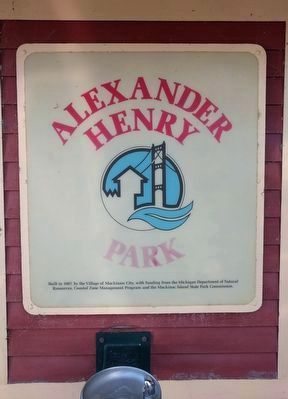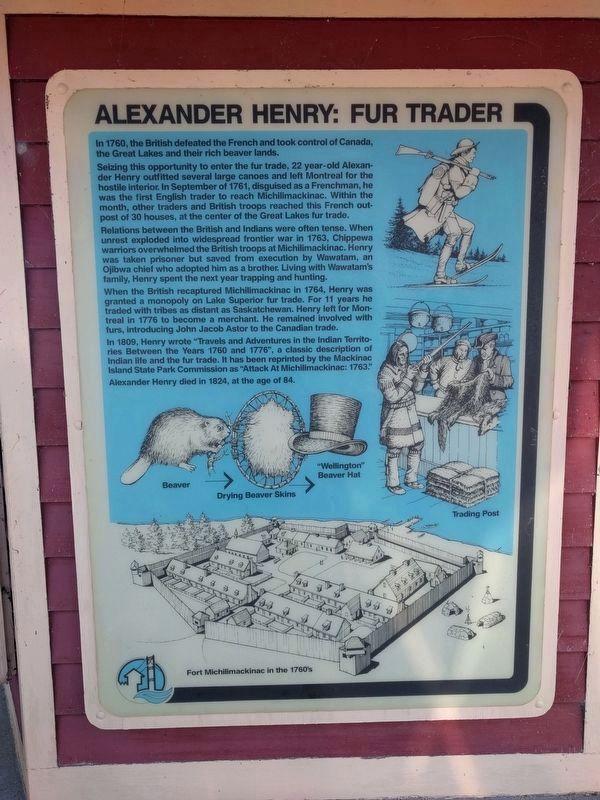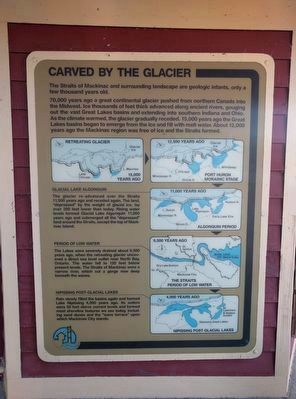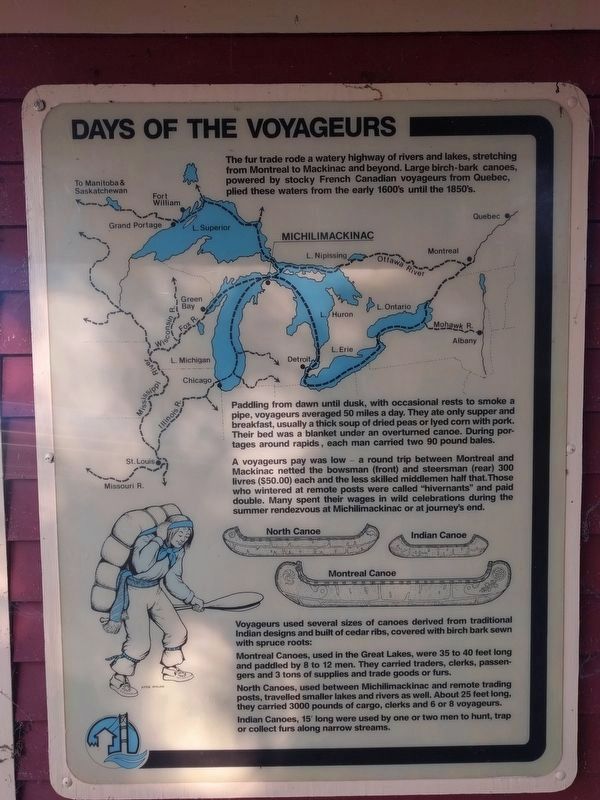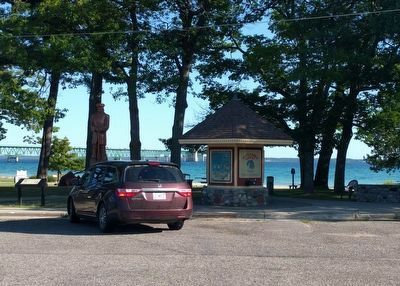Mackinaw City in Cheboygan County, Michigan — The American Midwest (Great Lakes)
Alexander Henry Park Kiosk
Alexander Henry Park
Built in 1987, by the Village of Mackinaw City, with funding from the Michigan Department of Natural Resources, Coastal Zone Management Program and the Mackinac Island State Park Commission.
Alexander Henry: Fur Trader
In 1760, the British defeated the French and took control of Canada, the Great Lakes and their rich beaver lands.
Seizing this opportunity to enter the fur trade, 22 year-old Alexander Henry outfitted several large canoes and left Montreal for the hostile interior. In September of 1761, disguised as a Frenchman, he was the first English trader to reach Michilimackinac. Within the month, other traders and British troops reached this French outpost of 30 houses, at the center of the Great Lakes fur trade.
Relations between the British and Indians were often tense. When unrest exploded into widespread frontier war in 1763, Chippewa warriors overwhelmed the British troops at Michilimackinac. Henry was taken prisoner but saved from execution by Wawatam, an Ojibwa chief who adopted him as a brother. Living with Wawatam's family, Henry spent the next year trapping and hunting.
When the British recaptured Michilimackinac in 1764, Henry was granted a monopoly on Lake Superior fur trade. For 11 years he traded with tribes as distant as Saskatchewan. Henry left for Montreal in 1776 to become a merchant. He remained involved with furs, introducing John Jacob Astor to the Canadian trade.
In 1809, Henry wrote "Travels and Adventures in the Indian Territories Between the Years 1760 and 1776", a classic description of Indian life and the fur trade. It has been reprinted by the Mackinac Island State Park Commission as "Attack At Michilimackinac: 1763."
Alexander Henry died in 1824, at the age of 84.
Carved by the Glacier
The Straits of Mackinac and surrounding landscape are geologic infants, only a few thousand years old.
70,000 years ago a great continental glacier pushed from northern Canada into the Midwest. Ice thousands of feet thick advanced along ancient rivers, gouging out the vast Great Lakes basins and extending into southern Indiana and Ohio. As the climate warmed, the glacier gradually receded. 15,000 years ago the Great Lakes basins began to emerge from the ice and fill with melt water. About 12,000 years ago the Mackinac region was free of ice and the Straits formed.
Glacial Lake Algonquin
The glacier re-advanced over the Straits 11,500 years ago and receded again. The land, "depressed" by the weight of glacial ice, lay over 200 feet lower than today. Rising water levels formed Glacial Lake Algonquin 11,000 years ago and submerged
all the "depressed" land around the Straits, except the top of Mackinac Island.
Period of Low Water
The Lakes were severely drained about 9,500 years ago, when the retreating glacier uncovered a direct sea level outlet near North Bay, Ontario. The water fell to 120 below present levels. The Straits of Mackinac were a narrow river, which cut a gorge now deep beneath the waves.
Nipissing Post-Glacial Lakes
Rain slowly filled the basins again and formed Lake Nipissing 4,000 years ago. Its waters were 50 feet above current levels and formed most shoreline features we see today, including sand dunes and the "wave terrace" upon which Mackinaw City stands.
Days of the Voyageurs
The fur trade rode a watery highway of rivers and lakes, stretching from Montreal to Mackinac and beyond. Large birch-bark canoes, powered by stocky French Canadian voyageurs from Quebec, plied these waters from the early 1600's until the 1850's.
Paddling from dawn until dusk, with occasional rests to smoke a pipe, voyageurs averaged 50 miles a day. They ate only supper and breakfast, usually a thick soup of dried peas or lyed corn with pork. Their bed was a blanket under an overturned canoe. During portages around rapids, each man carried two 90 pound bales.
A voyageurs pay was low — a round trip between Montreal and Mackinac netted the bowsman (front) and steersman (rear) 300 livres ($50.00) each and the less skilled middlemen half that. Those who wintered at remote posts were called "hivermants" and paid double. Many spent their wages in wild celebrations during the summer rendezvous at Michilimackinac or at journey's end.
Voyageurs used several sizes of canoes derived from traditional Indian designs and built of cedar ribs, covered with birch bark sewn with spruce roots:
Montreal Canoes, used in the Great Lakes, were 35 to 40 feet long and paddled by 8 to 12 men. They carried traders, clerks, passengers and 3 tons of supplies and trade goods or furs.
North Canoes, used between Michilimackimac and remote trading posts, travelled smaller lakes and rivers as well. About 25 feet long, they carried 3000 pounds of cargo, clerks and 6 or 8 voyageurs.
Indian Canoes, 15' long were used by one or two men to hunt, trap or collect furs along narrow streams.
Erected by Village of Mackinaw City.
Topics. This historical marker is listed in these topic lists: Colonial Era • Environment • Waterways & Vessels. A significant historical month for this entry is September 1761.
Location. 45° 47.204′ N, 84° 43.663′ W. Marker is in Mackinaw City, Michigan, in Cheboygan County. Marker is at the intersection of North Huron Avenue and Henry Street, on the right when traveling west on North Huron Avenue. Kiosk is at the southeast corner of Alexander Henry Park. Touch for map. Marker is at or near this postal address: 518 North Huron Avenue, Mackinaw City MI 49701, United States of America. Touch for directions.
Other nearby markers. At least 8 other markers are within walking distance of this marker. Alexander Henry 1739 - 1834 (here, next to this marker); Graveyard of the Deep (within shouting distance of this marker); Building Mighty Mac (within shouting distance of this marker); Crossroads of the Great Lakes (within shouting distance of this marker); Shipwrecks in the Straits (within shouting distance of this marker); Old Mackinac Point Lighthouse (about 400 feet away, measured in a direct line); Radio Beacon 1937/1938 (about 500 feet away); Marine & Weather Reporter (about 500 feet away). Touch for a list and map of all markers in Mackinaw City.
Also see . . . Travels and adventures in Canada and the Indian territories, between the years 1760 and 1776. Internet Archive website entry (Submitted on October 17, 2019, by Joel Seewald of Madison Heights, Michigan.)
Credits. This page was last revised on January 13, 2022. It was originally submitted on October 16, 2019, by Joel Seewald of Madison Heights, Michigan. This page has been viewed 178 times since then and 12 times this year. Photos: 1, 2. submitted on October 16, 2019, by Joel Seewald of Madison Heights, Michigan. 3, 4, 5. submitted on October 17, 2019, by Joel Seewald of Madison Heights, Michigan.
